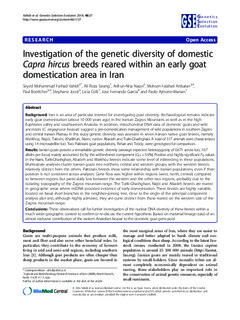| dc.contributor.author | Vahidi, Seyed Mohammad Farhad | |
| dc.contributor.author | Tarang, Ali Reza | |
| dc.contributor.author | Naqvi, Arif-un-Nisa | |
| dc.contributor.author | Falahati-Anbaran, Mohsen | |
| dc.contributor.author | Boettcher, Paul | |
| dc.contributor.author | Joost, Stéphane | |
| dc.contributor.author | Colli, Licia | |
| dc.contributor.author | Fernando Garcia, Jose | |
| dc.contributor.author | Ajmone-Marsan, Paolo | |
| dc.date.accessioned | 2019-11-05T09:00:11Z | |
| dc.date.available | 2019-11-05T09:00:11Z | |
| dc.date.created | 2014-06-22T15:40:21Z | |
| dc.date.issued | 2014 | |
| dc.identifier.citation | Genetics Selection Evolution. 2014, 46 (1), 27-?. | nb_NO |
| dc.identifier.issn | 0999-193X | |
| dc.identifier.uri | http://hdl.handle.net/11250/2626511 | |
| dc.description.abstract | Abstract Background Iran is an area of particular interest for investigating goat diversity. Archaeological remains indicate early goat domestication (about 10 000 years ago) in the Iranian Zagros Mountains as well as in the high Euphrates valley and southeastern Anatolia. In addition, mitochondrial DNA data of domestic goats and wild ancestors (C. aegagrusor bezoar) suggest a pre-domestication management of wild populations in southern Zagros and central Iranian Plateau. In this study genetic diversity was assessed in seven Iranian native goat breeds, namely Markhoz, Najdi, Taleshi, Khalkhali, Naini, native Abadeh and Turki-Ghashghaei. A total of 317 animals were characterized using 14 microsatellite loci. Two Pakistani goat populations, Pahari and Teddy, were genotyped for comparison. Results Iranian goats possess a remarkable genetic diversity (average expected heterozygosity of 0.671 across loci, 10.7 alleles per locus) mainly accounted for by the within-breed component (GST = 5.9%). Positive and highly significant FIS values in the Naini, Turki-Ghashghaei, Abadeh and Markhoz breeds indicate some level of inbreeding in these populations. Multivariate analyses cluster Iranian goats into northern, central and western groups, with the western breeds relatively distinct from the others. Pakistani breeds show some relationship with Iranian populations, even if their position is not consistent across analyses. Gene flow was higher within regions (west, north, central) compared to between regions but particularly low between the western and the other two regions, probably due to the isolating topography of the Zagros mountain range. The Turki-Ghashghaei, Najdi and Abadeh breeds are reared in geographic areas where mtDNA provided evidence of early domestication. These breeds are highly variable, located on basal short branches in the neighbor-joining tree, close to the origin of the principal component analysis plot and, although highly admixed, they are quite distinct from those reared on the western side of the Zagros mountain range. Conclusions These observations call for further investigation of the nuclear DNA diversity of these breeds within a much wider geographic context to confirm or re-discuss the current hypothesis (based on maternal lineage data) of an almost exclusive contribution of the eastern Anatolian bezoar to the domestic goat gene pool. | nb_NO |
| dc.language.iso | eng | nb_NO |
| dc.publisher | BMC (part of Springer Nature) | nb_NO |
| dc.rights | Navngivelse 4.0 Internasjonal | * |
| dc.rights.uri | http://creativecommons.org/licenses/by/4.0/deed.no | * |
| dc.title | Investigation of the genetic diversity of domestic Capra hircus breeds reared within an early goat domestication area in Iran | nb_NO |
| dc.type | Journal article | nb_NO |
| dc.type | Peer reviewed | nb_NO |
| dc.description.version | publishedVersion | nb_NO |
| dc.source.pagenumber | 27-? | nb_NO |
| dc.source.volume | 46 | nb_NO |
| dc.source.journal | Genetics Selection Evolution | nb_NO |
| dc.source.issue | 1 | nb_NO |
| dc.identifier.doi | 10.1186/1297-9686-46-27 | |
| dc.identifier.cristin | 1139809 | |
| dc.description.localcode | © 2014 Vahidi et al.; licensee BioMed Central Ltd. This is an Open Access article distributed under the terms of the Creative Commons Attribution License (http://creativecommons.org/licenses/by/2.0), which permits unrestricted use, distribution, and reproduction in any medium, provided the original work is properly credited. | nb_NO |
| cristin.unitcode | 194,66,10,0 | |
| cristin.unitname | Institutt for biologi | |
| cristin.ispublished | true | |
| cristin.fulltext | original | |
| cristin.qualitycode | 2 | |

